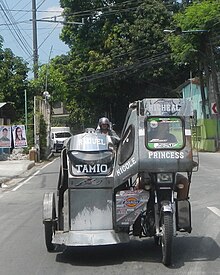Our website is made possible by displaying online advertisements to our visitors.
Please consider supporting us by disabling your ad blocker.
Motorized tricycle (Philippines)




In the Philippines, motorized tricycles, or simply tricycles (Filipino: traysikel; Cebuano: traysikol), refer to a type of motorized vehicle consisting of a motorcycle and a passenger cab attached to it. Along with the jeepney, the Philippine tricycle is one of the most common means of public or private transportation in the country, especially in rural areas. These public utility vehicles either ply a set route or are for-hire, like taxis.[1]
Philippine tricycles are built in a variety of styles, which differ from city to city, and are usually made locally by building a sidecar and affixing it to an imported motorcycle. Usually both the cycle and sidecar are covered, but not always by the same roof. Larger companies, such as Fitcor Marketing, also manufacture passenger tricycles.[2] They are built with more seats, with the motor situated at the back rather than below the driver as per a motorcycle.
Philippine tricycles are often confused with the similar tuktuks and auto rickshaws of neighboring countries. Philippine tricycles evolved from motorcycles with sidecars used during World War 2 and are not derived from rickshaws. These tricycles also attach the passenger cab to the side of the motorcycle, in contrast to tuktuks, which are not motorcycles but factory-built three-wheelers. The motorela, a regional variant of the Philippine tricycle with a centered passenger cab enclosing the motorcycle, is the most visually similar to a tuktuk, but differs in that it has four wheels, not three. The passengers of a motorela also sit sideways rather than face forward.
- ^ "Motorized Tricycles". Boracay Budget Travel Tips. Archived from the original on June 30, 2012. Retrieved April 27, 2013.; William C. Pollard, Jr., email to Lonely Planet, November 1, 2010, p. 2.
- ^ Bloom, Greg; Grosberg, Michael; Jealous, Virginia; Kelly, Piers (2009). Philippines. Lonely Planet. p. 450. ISBN 978-1741047219.
Previous Page Next Page


